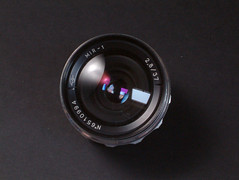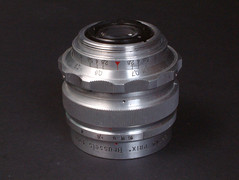Mir-1
The Mir-1 is a 37 mm f/2.8 lens made by KMZ and later other Soviet factories for a number of 35 mm SLR cameras. It was designed by D.S. Volosov in 1954[1] and was in production from the late '50s. The design was based on Pentacon's Flektogon 1 of the same length and aperture.
First model
The first model of the lens was produced by KMZ for the early Zenit cameras with an M39 lens mount; it is the widest lens commonly available for those cameras. It is silver-bodied. It has preset aperture control, between f/2.8 and f/16. It focuses to 0.7 m. It has an M49 x 0.5 filter thread (whereas most western '49mm' filters and hoods have a M49x0.75 thread, and will not attach more than minimally). Some examples of this lens, and many of those subsequently made by ZOMZ, are engraved "GRAND PRIX" Brussels 1958; this prize at the Brussels World's Fair was awarded to a set of lenses, not just the Mir-1.[2]

|
| image by Dustin McAmera (Image rights) |

|
| Mir-1 made by ZOMZ. image by Dustin McAmera (Image rights) |
Other models
- Mir-1 (ZOMZ)
After 1960, production of the silver-bodied M39-mount lens was transferred to ZOMZ in Zagorsk.[3] This is distinguishable from the KMZ model only by the maker's spiral-and-arrow logo on the front, instead of KMZ's prism-and-arrow one.
This is a black-bodied lens with an M42 mount[5], still with preset aperture control. This lens has an M49 x 0.75 filter thread.
- Mir-1C (KMZ)
This model was produced for the Zenit 4 line of cameras, which have a different film register from other Zenits. It has an in-lens shutter.
This is another black-bodied, M42-mount model, still with preset aperture control.
- Mir-1A
This black-bodied model is adaptable to several lens mounts by use of thread adapters.[8] It has preset aperture control.
- Mir-1 Automat
This black-bodied model was produced by Arsenal in Kiev for the Kiev 10 and Kiev 15 cameras, which have automatic exposure. The lens has automatic aperture and there is no manual aperture ring.
Notes
- ↑ Mir-1 notes (in Russian) formerly at the KMZ Archive website ( http://www.zenitcamera.com) and archived at the Internet Archive 'Wayback Machine' in July 2011; images of several models of the lens, as well as a cross-sectional diagram.
- ↑ 'KMZ archive' site.
- ↑ Zagorsk, given this name after revolutionary Vladimir Zagorsky in 1930 because its original name Sergiyev Posad refers to a Saint, reverted to its original name in the 1990s.
- ↑ The 'B' refers to Vologda, the town where VOMZ is.
- ↑ Since the film register of the M39 and M42 cameras is the same, it is possible to use the M39-mount lenses on M42 cameras with a simple thread adapter ring.
- ↑ The W-like character is a Russian 'Sha', and refers to 'school' according to the 'KMZ archive' site; perhaps this was a low-price version, or made specifically for educational supply.
- ↑ According to Nathan Dayton's 'Communist Cameras' site (archived at Archive.org, February 2021).
- ↑ The lens discussed on Alfred Klomp's Cameras may be one of these.